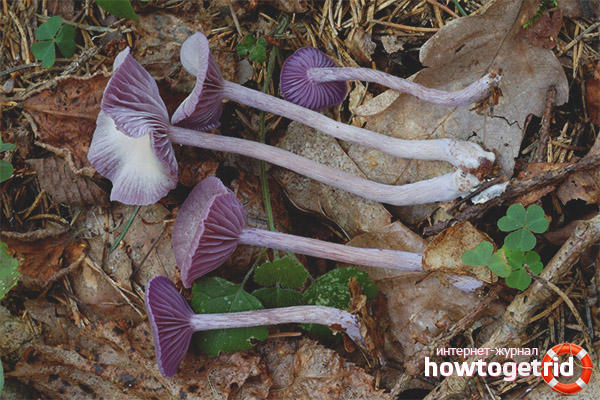The content of the article
Lacquer amethyst or Latin Laccaria Amethystina, belongs to the mushroom family Ordinary. Varnish is considered an edible mushroom. Because of its lilac or lilac coloration, this mushroom has received another unusual nickname among people - lacquer lilac.
Appearance of amethyst varnish
In young mushrooms, the amethyst caps are hemispherical in shape, but as they mature, the cap straightens and its surface becomes flat. The mushroom hats have a small diameter and grow from 1 to 5 cm. On the surface of the hat there are almost imperceptible scars and light dashes along the edge.
Young fungi have a bright purple color, but over time, the surface of the hat dims. The cap of the old mushroom is not so bright, and with age acquires a faded pinkish tint. The hat acquires the same dull shade in dry weather. The inside of the mushroom cap has a soft consistency, the pulp itself is also painted in lilac color. The pulp core has a delicate texture and a pleasant aroma.
Below, under the mushroom hat, you can see thin and sparse plates that have grown to the mushroom leg. The plates are painted in lilac color, however, the more the mushroom ages, the more whitish and light they become. Spore powder has a white or slightly purple hue.
The leg of the lacquer lilac has a fibrous surface of cylindrical shape. The inside of the leg has a hollow space, light villi are visible on the surface of the leg. The base of the legs also has a purple hue. The mushroom leg can grow on average from 3 to 10 cm in length, the width of the legs is only 0.8 cm.
The inside of the fungus in the context also has a purple color. The pulp is slightly watery, thin to the touch. From the mushroom comes a pleasant aroma and delicate taste. The leg structure is coarser and fibrous over the entire length, drier and stiffer than the cap.
Edible edible purple
Amethyst varnish is usually classified as a mushroom suitable for use in food. Varnish is included in the list of edible mushrooms of the 4th category. However, only mushroom caps are usually used for cooking. Therefore, inexperienced mushroom pickers should remember the main rule: put only the caps of this mushroom in a basket. Experienced cooks often use varnish in combination with other types of mushrooms, adding it to all kinds of dishes. This variety produces excellent roast.
Note! It is known that the fruiting body of the varnish can accumulate arsenic and other harmful substances that are present in the ground. Due to its ability to absorb all the harmful components of the soil, mushrooms are used in cooking in small quantities. That is why they are often combined with other edible varieties as a culinary platter.
Places of growth and period of growth

Lilac lilac grows on moist soil, where there is a lot of moss and a lot of forest. You can usually find it under coniferous trees. But it also grows in areas with mixed and deciduous forests, next to beech and oak trees. Sometimes varnish is found immediately by the whole family, forming a small mushroom group. This specimen begins to appear in the forest from mid-summer and grows until mid-autumn. Therefore, mushroom pickers should stock up with baskets, and already in July, feel free to go for prey.
Bright and quickly conspicuous lacquer is a frequent visitor in the woods. Her hats are very clearly visible on forest litter and among green moss, especially in humid places.Going for an amethyst lacquer into the forest, inexperienced mushroom pickers should learn to distinguish it from poisonous and related relatives.
Related and Venomous Doubles
Also, a similar coloring of the cobweb of violet at first glance can deceive inexperienced mushroom pickers. However, this edible variety of the fungus has a more massive and large form. In addition, in the cobweb of the violet plate under the hat are covered with a fibrous blanket. In adulthood, the hat of the purple cobweb becomes brown. Also in very dry weather, when the lilac hats become faded, it can be confused with another edible specimen - pink lacquer.










Submit